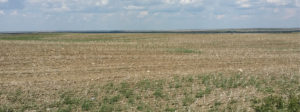Dry conditions help fall prices of feed crops and wheat
The 2018 crop year was certainly an interesting period as temperatures and crop conditions seesawed from one end of the spectrum to the other. Volatility was also present in commodity markets this year due to everything from global moisture conditions to trade agreements and trade disruption.
A large number of crops triggered the Variable Price Benefit or Spring Price Endorsement in the Annual Production Insurance program.
Dry conditions affecting Central and Southern Alberta led to declines in yield and affected prices, especially for local markets like feed grains and hay.
According to AFSC price listing, the 2018 fall market price of $5.24/bu for barley was 40 per cent higher than the spring price of $3.74/bu. Hay prices were similar with a 64 per cent increase from spring to fall in 2018.
“This has been a good year for feed crop prices if you’re growing them,” said Jesse Cole, Supervisor of Pricing, AFSC.
The jump in the fall price of barley also triggered similar increases in the fall prices for oats, rye, triticale, mixed grain and silage prices, as the pricing mechanism for these crops is based on barley’s spring to fall movement.
Cole believes that alongside the dry conditions, “healthy demand” from the livestock industry played a role with feed crop prices.
Bill Hoar, product owner for the Western Livestock Price Insurance Program, agreed.
“The demand for beef has been strong both in Canada and internationally, particularly in the U.S.,” he said.
Cole said producers of feed crops will benefit from the current range of prices in the market.
“Crops triggering the Variable Price Benefit will be valued at the higher price for hail and production claims to reflect the market in October.”
While feed crops have had strong prices, some other crops have seen declines. Worst affected were Kabuli chickpeas with a 53 per cent price drop in the fall compared to the AFSC spring price.
“Chickpeas have been on a wild ride. In the span of a year, they’ve seen a ten-year high and a ten-year low,” added Cole.
“Last year the Variable Price Benefit maxed out on chickpeas and this year it will do the same on the downside with the Spring Price Endorsement. It’s a real case of high prices solving high prices.”
Wheat prices boosted by global dry conditions
The 2018 crop year has seen dry conditions not only in North America but also in many wheat-growing regions of the world.
A global moisture map for 2018 shows Southeastern Australia, Western Europe, Black Sea Region and parts of South America, all major wheat production regions, having significant declines in precipitation rates.
Resulting declines in wheat crops in these regions have contributed to the rise in fall prices of some wheat varieties. Among them is Canada Prairie Spring wheat, which saw an 18.4 per cent rise in the AFSC fall price, landing at $5.96 a bushel. Special Purpose wheat price rose by 18.2 per cent while Hard Red Winter and Hard Red Spring each climbed 17.1 per cent.
“The hot and dry weather affected most major wheat exporters this year, which helped keep wheat prices fairly high,” concluded Cole.
“The exception was Durum, which suffered from the Italian Country of Origin labeling on pasta, and consequently, triggered the Spring Price Endorsement.”
